Devdutt Pattanaik's Blog, page 2
May 3, 2019
Mantra for VUCA markets: Adapt rather than align

Art by Devdutt Pattanaik
Published on 3rd May, 2019, in Economic Times
Modern Management is not based on rationality. It is based on two mythic constructs. Both these constructs originate from the West. The first is the Biblical construct and the second is the Greek construct.
The Biblical construct is most apparent in the idea of the vision statement and the mission statement where the desire is to create a better world and get an improved life. This construct comes from the Old Testament tale of the Promised Land, to which the slaves of Egypt were taken to by the Prophet. The idea of standard operation procedures comes to us from the Commandments of God, which have to be followed. Both internal and external auditors are constantly supervising everything, to ensure that no one breaks these Commandments.
Of course, in the modern management system, the role of God is being played by the shareholders, or the regulatory authorities. The whole approach is of judgment, for one is being judged constantly at the end of the first, second, third and fourth quarter. One is awaiting the great Judgment Day when the ones playing God decide which one is going to be promoted, rewarded or fired from the organisation to the corporate equivalent of heaven or hell.
Greek mythology manifests itself when people talk of passion and motivation. Motivational speeches are constant parts of sales meets. In these meets, everybody is called to be extraordinary, do their best and achieve or even surpass their targets, but without breaking the rules of the game. One is expected to be an athlete in Olympic Games, or a superhero, much like Batman or Superman: someone who is an ordinary being, but who must become extraordinary to solve the problems of life. While the corporate world follows a structure, which comes from Biblical mythology, every individual is asked to act as a hero, sacrificing his personal life for the good of the organisation, which requires superhuman efforts. So, it is not individualism as much as martyrdom which is celebrated.
However, today, the world has become very different. Vision statements are continually collapsing as the world is rapidly changing. We are now a part of a world where there is the relentless emergence of newer technology that upsets the apple card constantly. More attention is paid to the pertinent fact that nothing is constant, all contexts are continuously changing and innovation has become the name of the game. And so organisation structures are fluid, reporting lines are not fixed, targets are constantly reassessed, and talent is always on the move.
In other words, the paradigm has shifted, from a fixed paradigm that entails moving from an underdeveloped society to a developed society, to a paradigm where everything is in a flux, where even developed societies of the past are finding markets collapsing and jobs scarce. In the new paradigm of volatility, uncertainty, complexity and ambiguity, there is no beginning or end, as in Indian mythology, there is no climax, and there is no Promised Land, and there is no Judgement Day. There are booms and busts, happening constantly, and most times, simultaneously.
In other words, the mythic paradigm has shifted closer to the Indian paradigm. As a result, there comes a need to shift, from aligning to the set rules to adapting to a fluid situation. In other words, a superhero is now being expected to become an avatar. A superhero is an ordinary being, transforming into an extraordinary being. While an avatar is already an extraordinary being whose extraordinariness lies in becoming ordinary to solve problems.
Vishnu manifests this example by becoming Ram in Treta Yug and then Krishna in Dwapar Yug. In the same way, we are all being expected to reimagine and re-shift ourselves, as the market shifts and relentlessly transforms. We are expected to sometimes become rule-followers and sometimes become rule-breakers.
In other words, the old management by objective has run its course, after over 100 years. It is time to redefine modern management and align it to the Indian way. The Indian way talks about management by consequence, which thrives in uncertainty and offers no guarantee.
April 29, 2019
Hinduism and Buddhism

Art by Devdutt Pattanaik
Published on 28th April, 2019, in Mumbai Mirror
It was in the 19th Century that the wider world actually heard of the Buddha and Buddhism. Although Buddhism was practised for centuries in the Far East and Southeast Asia, people did not realise that the various images of the Buddha found in these countries belonged to the same person and that the person, originally, hailed from India.
This is when European Orientalists started translating Pali scriptures and the story of the Buddha first emerged. Sir Edwin Arnold wrote the book Light of Asia, which tells the story of the Buddha’s journey from prince to sage. It became an instant hit, across Europe, and informed Europe of this great sage.
These colonial scholars wondered why Buddhism was not popular in India, the land of the Buddha. They concluded it had to be because of the Brahmins, whose religion, from the polytheistic Vedas to the monotheistic Gita, made little sense to them, and whose hold on Indian kings and Indian society they had long learned to be wary of, and who were seen by influential Christian missionaries as the main obstacles to the path of conversion.
Despite huge evidence to the contrary (such as the breaking of Buddha idols and burning of Buddhist University of Nalanda by Muslim warlords), a narrative emerged that pitted Buddhism against Hinduism. Thus, Buddhism became a religion that propagated peace and favoured equality, hence was anticaste, while Hinduism became a religion of Brahmanical patriarchy that established the oppressive, ubiquitous caste system. Even today, when one travels around the world, the word “Buddha” evokes the emotion of peace, tranquillity and wisdom, while any mention of Hinduism evokes the notion of caste and misogyny.
Not just colonial propaganda, even academic papers have reinforced these ideas. Only now are scholars realising things are not so simple. While the older form of Buddhism based on meditation, Theravada, spread to Southeast Asia and the later form of Buddhism based on worship, Mahayana, spread to China, Buddhism’s decline in India, over hundreds of years, before the final Islamic onslaught, had more to do with a gradual absence of patrons. As regional kingdoms emerged, kings were increasingly drawn to Brahmin legitimisation of their kingship over the legitimisation by Buddhist monks. For a Buddhist king was protector of Buddha’s dhamma, while a Hindu king was the source of dharma itself, Vishnu on Earth, whose palace was not separate from the temple. Also, Buddhism valued the hermit over the householder, shunned entertaining art forms such as song and dance, saw all gods as serving the Buddha, while the Brahmanical way adapted Vedic thought to the ground realities: gods valued the household, gods loved to sing and dance and enjoy life, and village gods were diminutive forms of the cosmic divine. Even the Buddha was seen as a form of Vishnu.
That Buddhism favours the hermit over the householder, while Hinduism seeks to merge the hermit and the householder is evident in its mythology. Buddhacharita tells the story of a man who walks out on marriage and kingdom to become a sage, while the Shiva Purana talks about the great sage, on top of a mountain, who is coaxed to get married and have children. Buddhism frowned on laughter and saw laughter as the quality of women, children and animals – not suitable for a sage. By contrast in Hinduism, the goddess Durga laughs out loud when she runs into the battlefield to kill Mahishasura. Buddhist monasteries frowned at sexuality, while Hindu temples covered themselves with images of sexual freedom from the Kamashastra. Mahayana Buddhism speaks of the goddess Tara, but she is always shown smaller than the Buddha; in Hinduism the Goddess is, depending on context, smaller, equal or even bigger than Shiva or Vishnu.
People often point to Therigatha, the book of poetry written by Buddhist nuns, as an indicator of female emancipation in the Buddhist world. Few point to the extremely misogynistic writings found in the Vinaya Pitaka, the book of monastic discipline, where women are considered as evil creatures, temptresses, which is why there are more rules for nuns than for monks. Homosexuals were seen as not fit to be ordained as monks. In Jatakas, the Buddha-to-be takes forms of animals and plants and men, but never women; by contrast Vishnu becomes Mohini and Shiva becomes Ardhanarishwara.
All these misogynistic monastic principles of Buddhism eventually became part of the Hindu fold, when Hindu monasticism became mainstream, about a thousand years ago. We can argue forever if this historical process was cultural assimilation or cultural appropriation or cultural dilution. But the point remains that when one speaks of violence and misogyny and oppression in India today, even if they insist that India is not just Hindu, scholars tend to seek examples only from Ramayana and Mahabharata, and never from the Buddhist heritage. And that is problematic.
Dogs of the gods
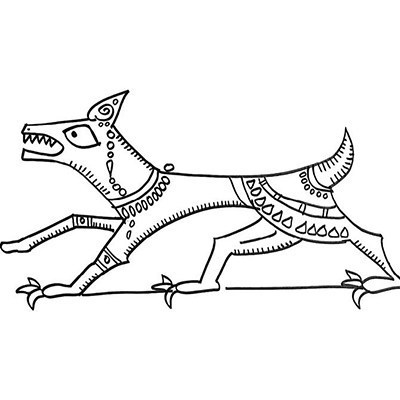
Art by Devdutt Pattanaik
Published on 28th April, 2019, in Mid-day
In traditional Hindu society, dogs are considered inauspicious. This is most evident in dharma shastras, which were put together about 2,000 years ago. Dogs were associated with death, as well as with pollution and, therefore, belonged to the periphery of society. Dog-eater was a common way of describing the Chandala community, who also lived on the periphery of villages and in crematoriums, and were seen as polluting by the rest of the village.
In all cultures, certain animals are given high status and low status. In Christianity, for example, the serpent is associated with the devil. In the Islamic world, greater value is given to the cat over the dog as Prophet Muhammad had a pet cat. This reveals how different meanings are given to different creatures in different cultures.
Dogs have been found in seals of Harappan civilisation. There are burial sites that predate the Harappan civilisation, where we find people buried with dogs. This would indicate that the dog was a much-loved, domesticated animal in India, since ancient times.
The earliest mention of the dog is in the Rigveda. In the Rigveda, we hear of a bitch called Sarama, who belongs to Indra, and helps in seeking out the cows of Indra, stolen by the Panis. So, one can consider Sarama as a hunting dog or a watchdog of Indra. Sarama’s children came to be called the Sarameya, and all the dogs in the world are considered to have descended from her. Specifically, the Rigveda mentions Shama and Shabala, the two children of Sarama, who are four-eyed animals, constantly associated with Yamaraj.
Because the dog is associated with death, we see it also associated with Bhairava, Shiva’s fierce form, who is called the guardian or protector of Kashi. As the kotwal of Kashi, he is seen riding dogs, again a reference to the dog being a watchdog, who stands at the periphery, protecting the inner world from external dangers.
In the Atharvaveda, Rudra is the lord of dogs. Shiva, it must be understood, was in that period also considered an outcast god. He is feared and kept at a distance, until he transforms into the auspicious Shiva of Puranas.
In the Mahabharata, it is a dog who accompanies Yudhisthira to paradise. Yudhisthira insists that he will not enter heaven, unless the dog joins him. The dog is not allowed in as it is considered inauspicious, however Yudhisthira insists he should be taken in.
In one story, found in the Puranas, during times of starvation, Vishwamitra found no food and, in desperation, stole dog meat from the Chandalas and started to cook it. Horrified that the great sage was going to eat dog meat, Indra brought rains and the drought came to an end. In another story, we hear how Vishwamitra curses Vasishtha that his children for several generations would be born as dogs.
In much later literature, we find the fierce dogs of Bhairava transforming into four gentle puppies, embodying the Vedas who accompany Dattatreya. Dattatreya, the first guru of the Nath Jogis, challenged the old Vedic orthodoxy that considered the dog inauspicious.
April 22, 2019
The metaphor of the forest
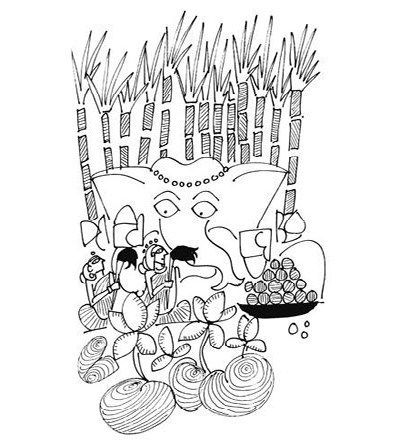
Art by Devdutt Pattanaik
Published on 21st April, 2019, in Mid-day
To understand Hindu mythology, it is critical to understand the metaphor of forests. Forests represent the default wild world, where might is right, where strong prey on the weak; while culture represents the world, where the forest has been domesticated, where might is no longer right, and the strong take care of the weak. In fact, the transformation of human settlements into civilisations is seen as the journey from the desire to dominate and be territorial, like an animal, to a space where the mighty help the meek and even the helpless can thrive.
Thus, we find the Samaveda melodies classified into two types: those that should be sung in a settlement and those that are sung in the forest. This division is crucial to understand the transformation of humans from animals to superhuman beings. From a world where they are consumed by hunger and fear, to a world where they outgrow hunger and fear, and can empathise with the hunger and fear of others.
In the Rig Veda, the forest is associated with a goddess called Aranyani, who is described as wearing anklets and is a dancer. She is never seen, only heard. One wonders how she lives so far from human settlement and can feed all manners of living creatures without ever having to till the soil. This is the first understanding of the forests that we find in Hinduism.
In the epics, Ramayana and Mahabharata, forests play an important role. Ram goes into an exile for 14 years and the Pandavas go for a 13-year exile. It is in this time that they are exposed to a world without kings. The king in Sanskrit is called ‘raja’ and a world without kings creates ‘a-raja-kta’ or disorder, where the weak are at the mercy of the strong. Ramayana and Mahabharata thus become epics that try to present the idea of dharma that must be established by kings, an ecosystem in which the law of the jungle has been overcome.
In Puranic literature, the forest plays a role as being the adobe of the gods. Shiva is associated with Daruka-vana, the cedar forest. Ganesh is associated with the forest of sugarcane, Ikshu-vana. Krishna is associated with Vrinda-vana, forest of basil. Hanuman is associated with the forest of bananas or Kadali-vana. The goddess is associated with Imli-vana or the tamarind forest, which is evergreen.
There are references to enchanted forests, where only women reside and any man who enters becomes a woman himself. Only men who have complete control over their senses, the yogis, can enter it.
A forest is, in a way, a space where there are no rules or regulations, no bondage, and where everything is fair — so long as you survive. It is a place of natural justice and not social justice. It is the place of food chains, pecking orders, herds and packs, and of territories established through violence. It is a place where everyone must take care of themselves and no one comes to anyone’s rescue. This sounds increasingly the direction that modern society is taking, doesn’t it?
April 21, 2019
For all its noble aspirations, social media is pure business.

Art by Devdutt Pattanaik
Published on 20th April, 2019, in Economic Times
Of late, people on Twitter have noticed that Twitter blocks accounts of people who complain against harassment of women. But men who harass women go scot free. It is no coincidence that the men who harass women seem to be associated with powerful political organisations while the women who complain are not. It is not clear, therefore, whether the act, by the social media barons and their team, is against women or in favour of political parties. It all comes down to business. For all its noble aspirations, social media is ultimately a business, whether it is Amazon, Twitter, Facebook or Apple.
People invest in technology to make money. Twitter exists to make money. Amazon exists to make money. Uber exists to make money. To make money, you need access to markets. To gain access to markets, you need to make sure that the controller of the market favours you. If the controller of the market shuts the door on you, you have no opportunity to enter the market. If you cannot enter the market, you cannot make money. There is a great demand for social media. It is a demand that was created by exploiting latent needs and emotive technology. But while the vision statement of the corporation constantly speaks about how the purpose of social media is to transform the world, this is unfortunately not true. It is designed to increase shareholders value.
Business schools teach management by objective (MBO) which is always about being clear about what our objective is. All nobility aside, ultimately, business is about increasing shareholder value. Therefore, new businesses are often in debt; but the valuation is so high, that it doesn’t matter, even if the company is in debt, because the value of the company is far greater than the actual money spent. China has, very cleverly, from its ancient times, used its wall, and in modern times, used its firewall, to restrict access to the market. So, while it is a supplier to the world, it very carefully controls what enters its market. Therefore, many social media companies have no access to the Chinese market, instead the Chinese have created their own products, which have now reached a level that if they are launched outside the Chinese firewall, they can destroy businesses that emerge from Europe and America.
Clearly, we realise how politics and economics are intertwined. Chanakya Artha Shastra is less about economics and more about manoeuvring political power to harness the wealth of the market, in favour of the king. It is not about creating a prosperous ecosystem for the subjects, or about making merchants rich, it is about ensuring the power of the king. Although Chanakya acknowledges the purpose of the king is to create a satisfactory business ecosystem for subjects, it is closely aligned with how the king uses this ecosystem to maintain his power.
If one reads the Books of Exodus in the Old Testament of the Bible, one realises what happens in markets. When the markets become exploitative, which is described metaphorically as slavery in Egypt, a new entrepreneur comes with the offer of a promised land (vision statement). The entire market moves with him to the Promised Land, where we are told there is more freedom and dignity. However, over time, the Promised Land, on becoming prosperous, establishes walls and firewalls and the old saviour ends up as the new king, who controls and enslaves the people he had once liberated.
So, we have a continuous cycle of slavery and liberation, with slavery being established by old business and liberation promised by new business. The cycle continues as economics enmeshed with politics. The king, eventually, wants to control the market and by controlling the market ends up destroying it. This is the cycle of boom and bust that we see everywhere. Right now, social media is being increasingly controlled by political forces, which will mark its demise until a new alternative comes and a new vision statement is provided. Then we move to a new Promised Land, as we admit that social media has failed the interests of the larger public.
April 15, 2019
Not quite division of labour
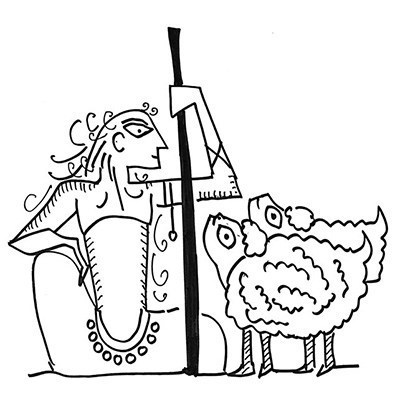 Published on 14th April, 2019, in Mumbai Mirror
Published on 14th April, 2019, in Mumbai Mirror
Many assert that the caste system (jati pratha) is essentially ‘division of labour’. However, this will never be said by those involved in manual scavenging, cleaning sewers without proper gear, being forced to take up this job because that is the only vocation made available to them. When we use the phrase ‘division of labour’, it means all forms of labour are respected equally and people can choose to be whatever they want to be. Manual scavenging is never a choice. Is it aspirational to be a doctor, or a janitor? Globally, labour is not treated equally.
Some jobs pay more, some jobs are respected more, some jobs are more aspirational than others. If all jobs were equally aspirational, we could talk about division of labour.
But while the caste system is easy to criticise, our understanding of it remains limited, as academicians and politicians and activists see it through the lens of equality: everybody is equal before the law and everyone must get equal opportunities from the State. This idea of equality comes to us from Abrahamic mythology where all creatures are born equal in the eyes of God and live one life, equally obliged to follow God’s commandments. Those who do not follow God’s commandments go to hell.
In modern politics, the State is God, created by the collective voice of the people. Its laws are commandments, created and modified by the people. This way of looking at the world did not exist in ancient India. Ancient India is based on karma. This is not the one and only life; therefore, we are not born with a clean slate. We are born with karmic baggage and we die with karmic baggage and this karmic baggage decides into which family we are born. Different communities have different gods and different ideologies. This is very different from a homogenous worldview where everyone has, or must have, the same God, and the same ideology, a belief that is common in right wing and left wing groups around the world.
Where there is diversity, there is bound to be hierarchy — economic and political. What is unique, and most disturbing, about caste hierarchy is the concept of purity, with some vocations being seen as purer than others, resulting in the practice of untouchability. We confuse caste with untouchability. That is like confusing identity with exploitation. They are two different things.
People also argue that the ‘original’ caste system was not determined by birth. The Bhagavad Gita is often quoted as stating: your varna (social role) is decided by your gunas (your qualities). But does that mean gunas decide who should be manual scavenger and who should be priest? Does the manual scavenger get the same respect as the priest? These are questions we don’t want to ask.
In traditional India, you were obliged to follow the family profession. The sons had to follow their father’s profession. Therefore, we find great tension, in ancient mythology, between sages who become warrior or warriors who become sages, charioteers who aspire to be archers, cowherds who wish to be kings. Choice does not exist in Indian society. The karma system does not allow you to have a choice. Again, choice is a very Christian concept, based on free will, where you choose God or Devil, or atheism.
The ‘upper’ castes who owned lands, and were literate, managed to secure jobs as bureaucrats in Mughal courts; though Islam believes in equality, Muslim kings of India realised there was value in respecting the caste system. Later, they got jobs in the offices of the East India Company. The British rulers as Christians, and creators of ‘liberal’ ideologies, believed in equality but had no problems reinforcing the caste system by making it part of the census. After independence, demands of democracy have ensured that castes serve as vote banks for politicians. Reservations may be powerful tool of social justice, but they are simultaneously a weapon to drive a wedge in the social fabric. Humans love inequality as it enables us to be powerful.
There are people who say caste system was created to establish inequality and legitimise exploitation. That is like saying Christianity and Islam were created to wipe out pagan polytheistic religions, that Capitalism was created to make the rich richer and that Socialism was created to establish mediocrity and destroy enterprise. In conspiracy theories, all systems turn into handmaidens of evil.
Faith: 40 Insights into Hinduism
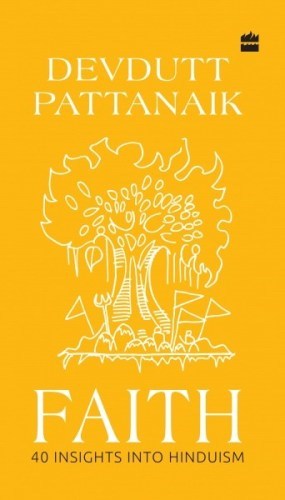
Faith: 40 Insights into Hinduism
Why are Hindus so ritualistic? Why do they worship idols? Were Hindus always casteist? Are Hindus supposed to be vegetarian? Is divorce permitted according to Hinduism? Why is a Hindu prayer different from a Muslim or Christian prayer? Did the arrival of Muslim invaders a thousand years ago destroy Hindu culture?
Answering key questions on Hindu philosophy and associated Indian history in simple, lucid, engaging ways, and exploring the often curious customs and beliefs that are an intrinsic part of the Hindu faith, Devdutt Pattanaik’s latest book is a treasure house of information on the complex tenets of Hinduism.
For many a curious reader, Faith: Understanding Hinduism will prove to be a delightful and eye-opening introduction to the intricacies of one of the world’s most practiced religions.
April 14, 2019
Indra’s rise to kingship
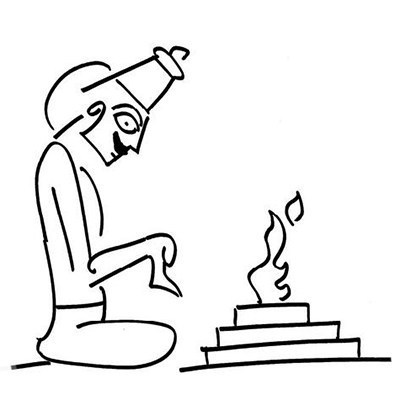
Art by Devdutt Pattanaik
Published on 14th April, 2019, in Mid-day
The Brahmana, orally transmitted by priests who came to be known as Brahmins, contain instructions and explanations for the Vedic ritual of yagya. All the four Vedic Samhitas have Brahmanas attached to them. The Brahmana associated with Yajurveda is called Taittiriya Brahmana. Here, we find stories related with Indra, which are not commonly told. They explain how kingship was seen in Vedic times, over 3,000 years ago, very different from how kingship came to be seen in Puranic times, in the past 2,000 years, by which time Indra had lost his exalted status and was seen as an insecure god, and inferior to Vishnu.
We are told that Prajapati creates the devas and Indra is the youngest deva. He appoints Indra as king, but since he is youngest, his rule is not accepted by his elder brothers. So, he goes back to Prajapati and asks Prajapati to give him his lustre. Prajapati passes on his lustre to Indra. As a result, Indra becomes more powerful than his brothers and they accept his right to rule over them. Prajapati, now lustreless, is eclipsed by Indra. Lustre here is a metaphor for power. Power is more important than seniority to make a king.
Then, there is the story of how Indra collected taxes from his subjects. He asked for a lot of taxes and people did not like it. He sent tax collectors to the east, and people moved to the south; he sent tax collectors to the south, and the people moved west; from the west, they moved to the north. Finally, he sent tax collectors to the north, and his subjects had nowhere to go. Indra had to send tax collectors as people never pay taxes voluntarily as they always think taxes are too high.
The third story tells us about the battle of Indra with his arch-enemy Vritra, the first of the asuras. Though Indra kills Vritra, he is unsure of whether he is really dead. So, he sends the Marut to confirm Vritra’s death. The Marut go to the battlefield and dance on the body of Vritra. Vritra does not move and that confirms he is dead. This dancing on the dead bodies on asuras turned Marut into the first dancers.
In another story, the asuras perform a yagya, to reach paradise (swarga). Indra approaches them, disguised as a Brahmin, and asks to participate in the yagya. Each asura and Indra create a brick that is used to make the great fire altar. As the yagya is reaching its climax, Indra removes his brick, causing the great altar to collapse. As a result, the asuras turn into spiders, vomiting sticky substances. Only two asuras manage to reach swarga, but in the form of celestial dogs.
Finally, there is the story of how Indra lies to the asuras that he will not kill them, but ends up killing them as they sleep. Since he used falsehood to win the war, he performs a ritual of purification and after removing the falsehood, returns to swarga.
All these stories show an understanding of Vedic rituals, which were created to cleanse ambitious, young kings of their dark deeds. As per legend, the sage known as Yajnavalkya rejected such rituals, as they enabled and condoned unethical acts. This angered his guru, who asked Yajnavalkya to vomit out all he had learned. This vomit was consumed by other students, who took the form of partridges, or the Tittiri bird. Therefore, the knowledge that was regurgitated came to be known as Taittiriya Brahmana.
April 8, 2019
Desire’s bow and destiny’s noose

Art by Devdutt Pattanaik
Published on 7th April, 2019, in Mid-day
Elections are a time to express desire, while the time in between is to face our destiny. For the arrow of our desire creates the noose of our destiny. In Hindu mythology, desire and destiny are the two principles governing all life. Desire propels action; action creates reaction; and reaction creates the circumstances we experience from which we cannot escape. In other words, desire eventually creates destiny.
Desire emerges with the transformation of a non-living object into a living organism that experiences hunger, thirst, yearning and longing. If there was no hunger or thirst, there would not be any life. Kamadeva, or the god of love, is associated with a bow made of sugarcane, of which the bowstring is made of bees and butterflies and the arrows are tipped with flowers. The bow symbolises a weapon that fills the body with longing. When struck by Kama’s five arrows, we come alive with desire, we yearn for food, satisfaction, pleasure and survival. In the hermetic traditions of India, including Buddhism, Jainism and Hinduism, the monks said that desire is the cause of all suffering. Desire became adverse. Therefore, the purpose of life became outgrowing it.
In mythology, Shiva opens his third eye and sets aflame the god of love and turns him into a heap of ash. However, the goddess confronts Shiva and demands that he resurrect the love god. Because, without the love god, nature cannot function. Shiva realises the dangers of curbing desire and Kama is resurrected, in the form of a goddess, called Kamakshi or even Kamini, the one who evokes desire. Shiva then becomes from Kamantaka (destroyer of desire) to Kameshwara (master of desire).
If desire is represented by events over which we have no control, destiny is represented by the Pāśā or noose that binds us to experience the destiny created by our own desires. This is Karma. People popularly confuse Karma with fatalism. However, that is an incomplete understanding of Karma. Karma is both: actions we do voluntarily and actions we perform involuntarily. This is conceptualised as the noose of Yama.
Yama is the god of death and rebirth. He maintains the record of all our actions: the debts we incur in our life, through desire, which we must repay in a future life. The noose of Yama is really the noose of debt that binds us to the cycle of birth and rebirth. Only when we repay our debts does the noose liberate us and we attain what is called moksha or mukti: freedom from hunger, fear, attachment and the circle of life and death. When one is dying, Yama hurls the noose and pulls the life-breath out of the body. He keeps one tied to this noose until one repays their debts, which is essentially the reactions of past actions. These reactions create either good or bad contexts in our life, which we are obliged to endure in our future lives.
Kama’s bow and arrow hold the potential of the choice of actions, what we choose in response to the destiny we encounter. Yama’s noose embodies what fate has in store for us. The arrows we shoot in the election booth will determine the noose that will follow.
April 6, 2019
Remembering the contribution of Courtesans
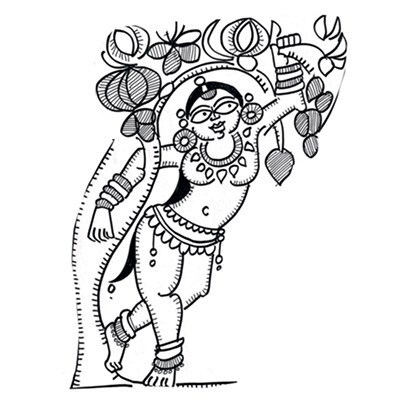
Art by Devdutt Pattanaik
Published on 6th April, 2019, in Economic Times
In ancient Indian scriptures, we find a description of three kinds of women.
Women who were chaste and devoted to a single man (even if the man had many wives). The second were women who kept away from men and lived as nuns. The third kind were women who had multiple lovers and were attached to no single man. In later times, such women were considered the wives of a temple deity or a devdasi, who saw their god in all their lovers. This last kind of women has often been described in modern literature as ancient sex workers or prostitutes or sacred concubines.
We refuse to see them as single women who indulged in the profession of entertainment, by being singers and dancers. They were known as nats and natis, or entertainers, who chose not to be bound to a single man and had multiple lovers. They were part of matriarchal clans, where the property and inheritance passed on from mother to daughter.
Instead of seeing theirs as a different lifestyle, they have been condemned. Their lifestyle has been reduced to the term prostitution and therefore we refuse to see this as one of the many types of diverse community structures which thrived and were given due importance, in ancient India.
The idea of beautiful women, who are well versed in the arts, and bound to no single man, emerges in mythology in the references to the apsaras. In the Rigveda, the apsaras reside in the paradise known swarga, which human males crave and pine for. But these apsaras seem to get disinterested and detach themselves from human beings, after no given period. They are uninterested in the concept of fidelity. Even when they bear offspring, they are not attached to the children and leave them behind, at times even on the forest floor. In other words, these are free women. Puranas state that when the devas and the asuras churned the ocean of milk, Laxmi, the goddess of fortune, emerged and, with her, arose the apsaras, who made heavens their abode and entertained the gods.
In later Nath traditions, these free women were considered to be yoginis and dakinis who lived in plantain forests: a plantain being a metaphor for women. It is said that the plantain grove was the realm of witches who stripped men of their masculinity and trapped them in the world of mortality. It was a world dreaded by the monastic order. The monks feared them as creatures who strip men of wealth and power and capture it themselves.
In early Buddhist literature, the courtesans also played a very important role. We are told that many of them were so rich that they gifted groves, houses, food and wealth to many Buddhist monks and even to the Buddha. But, in later literature, we find a discomfort with these women; they are considered temptations, destroying concentration and waylaying the ascetic. In Hindu literature, Indra sends apsaras such as Menaka from paradise to distract rishis like Vishwamitra from gaining spiritual power, even though their images adorned temple walls.
These reveal a social tension between the ascetic and artistic traditions, the hermit and the entertainer, the former being more masculine and the latter more feminine.
When Islam came to India, we see the courtesans thriving in the form of the tawaif. They played a very important role in the rise of Indian music and dance. In temples across India, there were vast communities of women associated with music, dance and the arts. These women were considered to be exponents of the 64 different kinds of arts, which meant many of them were literate, being educated in the subjects of poetry and prose. We know of famous courtesans who wrote poetry. They also found renown as exponents of the various musical forms.
The arrival of the British changed all that. With the British, especially in Victorian times, came a colonial morality and an idea of virtue. Anything associated with sex and sexuality was condemned as being evil and wrong. Unsurprisingly, the ones to suffer the most was this community of independent women artists.
Incredibly, modern Hindu puritans mimicked Victorian Puritanism and called it ‘tradition’.
Hindu reformists tried to change Hinduism and align it with Christianity and, subsequently, with Christian puritanical doctrine – thereby, these women were perceived to be stains on Hindu culture.
Thus, began a systematic movement to destroy these independent women, by reducing their role in society to prostitution and consequently, condemning and shunning them.
The idea of the independent woman as someone to be feared, continues to this date. We can see clearly, on the internet, how single women are targeted by trolls. These trolls typically use sexual metaphors and see these freethinking women as loose, rather than being autonomous. In doing so, we have denied the grand contribution of women artists and entrepreneurs to Indian culture – and that is unfortunate.



